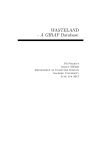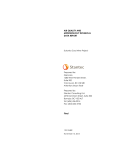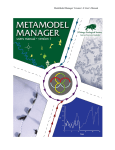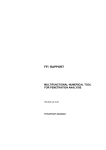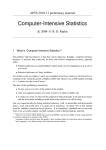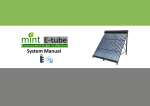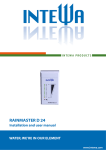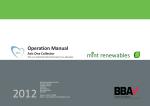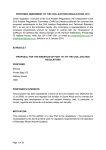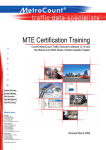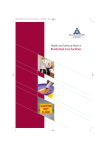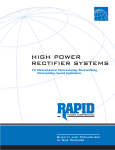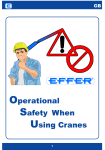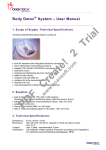Download Contractor handbook
Transcript
Handbook for contractors at
Nikkelverk
This is not necessarily the most recent version of the document – see www.nikkelverk.no for
the current, updated version.
REVISION HISTORY
Revision
no.
3
4
5
Date
Section
Page(s)
Objective of change
March 2011
May
13/5-11
All
All
All
All
All
All
6
11.09.11
7
30.11.2012
3.3.10
2
2
8
17.10.2013
3.3
17
8
7
8
9
19
1, 3.3.5
6, 18
3
2.2
12
9
Original document
Updated scaffolding instructions
New section concerning angle grinders
Revision history
General corrections
New regulations for working at a height
Work clothing
Life-saving rules
Control of entry and exit
Regulations for use of reflective vests
Regulation on electrical equipment in confined
spaces
New front page with new Logo and company
name
Changed text regarding JSA and TSF to get
same text in this handbook and HSEhandbook
Foreign certificates
Time-recording
Life-saving rule # 7
Layout/editing.
Clarification regarding prequalification of subcontractors
Updated reference to regulation
Minor changes
New
Updated reference to regulation
9
13.06.2014
2
8
10
25.11.2014
1
4
2.4
App. 2
App. 3
App. 4
11
24
28
30
2
Contents
REVISION HISTORY ...................................................................................................................................... 2
INTRODUCTION ................................................................................................................................................... 4
General section ........................................................................................................................................... 5
Persons speaking a foreign language ..................................................................................................... 6
Information about local circumstances .................................................................................................... 6
2 GENERAL SAFETY REGULATIONS AND MANDATORY SAFETY EQUIPMENT ...................................................... 8
2.1 LIFE-SAVING RULES ..................................................................................................................................... 8
2.2 Access control and time registration ................................................................................................. 9
2.3 Regulation of internal traffic at Nikkelverk ........................................................................................ 9
2.4 Mandatory safety equipment .............................................................................................................. 9
3 CERTIFICATES AND INTERNAL REGULATIONS ............................................................................................... 12
3.1. W ORK INVOLVING FLAMMABLE HAZARDS ................................................................................................. 14
3.1.1
General .................................................................................................................................... 14
3.1.2
Certification ............................................................................................................................. 15
3.1.3
Issuer of work permits ........................................................................................................... 15
3.1.4
Recipient of a work permit .................................................................................................... 15
3.1.5
Completion and post-inspection .............................................................................................. 15
3.1.6
Extended work permit ............................................................................................................... 15
3.1.7 Welding and flame cutting equipment ..................................................................................... 16
3.2 HOT WORK, IN AREAS THAT CARRY A FIRE/EXPLOSION HAZARD ............................................................... 16
3.2.1 Work permits .................................................................................................................................... 16
3.2.2 Watchman ........................................................................................................................................ 17
3.2.3 Gas measurement/certificate ........................................................................................................ 17
3.3 W ORK PERMIT SYSTEM FOR COLD WORK .................................................................................................. 18
4 INJURIES AND 'NEAR MISSES' ........................................................................................................................ 22
5. APPENDIXES ................................................................................................................................................. 23
Appendix 1 – Schematic overview of hot work ..................................................................................... 23
Appendix 2 - Access control .................................................................................................................... 24
Appendix 3 - Internal traffic at Nikkelverk .............................................................................................. 27
Appendix 4 Ladders and scaffolding at Nikkelverk .............................................................................. 29
Appendix 5 - Overview of enclosed rooms/spaces at Nikkelverk ...................................................... 30
Appendix 6 Table of certificate issuers .................................................................................................. 31
3
Introduction
At Nikkelverk we are obliged to carry out HSE work according to the highest
standards, in close cooperation with local operators and by following principles for
sustainable development.
Via our HSE management system we ensure that we:
Fulfill, and if possible, surpass the stipulations of applicable laws, directives,
standards and regulations.
Work constructively with the local community, public authorities and other
involved parties.
Identify, evaluate and handle risks to employees, the environment and
surrounding communities.
Establish goals for our HSE work and analyze our achievements through
continual and precise reporting.
Communicate and consult employees and suppliers in order to develop our
HSE system.
Ensure that employees are competent in safeguarding and taking
responsibility for correct HSE within their own areas of responsibility.
Limit environmental damage from our production by maintaining an effective
use of natural resources and by reducing material consumption and the
amount of waste.
Contribute to maintaining biological diversity.
Plan, design, operate and decommission plants in a manner that safeguards
principles for sustainable development.
Safeguard basic human rights.
Determine the direct and indirect cause of undesirable incidents and
hazardous situations, and implement action that prevents these from
reoccurring.
Purpose
This contractor handbook is designed to provide our contractors with a good
overview of our HSE routines and to provide operational guidelines to the individuals
working at our company. The regulation in the contractor’s handbook applies to both
contractors and sub-contractors.
HSE and our contractors
As a contractor with Nikkelverk, we expect that you as a company focus on HSE
improvements. Being able to demonstrate a good safety record (H-value or similar) is
an important criterion for us when evaluating tenders. It is an objective that all
persons working at our company, employees and hired personnel, shall have a
conscious attitude to HSE, in all work they perform. The Nikkelverk has the policy
that all contractors must be prequalified and approved for work on site.
4
Use of sub-contractors
The contractors are responsible for the follow-up of their own sub-contractors. All use
of sub-contractors on site at Nikkelverk must be pre-qualified and approved by
Nikkelverk.
Request to report undesirable incidents
When your personnel perform work at our company, we expect that they report
undesirable incidents, near accidents/near-misses and similar. This is done by
notifying their contact person about the incident. Reporting undesirable incidents is
an important part of our preventive work, and must not be considered to be negative
'telling tales'. It may well be that reporting an issue leads to the prevention of a
serious accident.
Contact and follow-up
For all our contractors, we have a defined a responsible contact person. This person
is the main contact for you as a company.
We continually follow up our contractors and will invite them to meetings, to discuss
HSE development and incidents, supply quality and similar, as required.
General section
All contractors with framework agreement shall perform daily safety meetings.
All personnel from contractors that are to perform work at Nikkelverk must have
completed a safety course in advance. This course is taken online and enrolment can
be arranged by contacting the Reception, tel. +47 38 10 10 10. The course contains
information concerning the company's safety and protection requirements, the
company's environmental policies and general environmental issues. In addition, the
contact person will inform of any particular issues regarding special awareness in an
environmental context at the relevant workplace.
The part of the course on performing hot work is part of the ordinary safety course.
Persons who are to perform works of a short duration and do not wish to take the
safety course must be supervised by an employee of Nikkelverk as long as this
person is carrying out work at the company.
All persons, on arrival at the company on the first day, must contact the Reception.
Our safety manual and a hard hat badge will be given out - these document the
approved safety course. This certification is valid for two years. The Reception will
also notify of the contact person within the company.
In order to perform work in the various departments, further localized safety training
will be required. The Foreman of the relevant department is responsible for this
training. You must have documentation of completed local training in the Safety
Handbook.
If you are to work in areas with electrical current hazards, a separate electrical
hazard safety course must be completed. Contact the Electro Dept.
Working at a height also requires separate safety training. The Personnel Dept.
(Training Manager) has an overview of courses.
5
When working close to high-voltage cables or conductor rails, additional training must
be given by a qualified electrician.
When working in the sulfuric acid factory, additional safety training is required - this
will be provided by the Foreman Calcination/sulfuric acid factory.
There are requirements in respect of various work permits within the company.
Written work permits have three codes:
Red is used for hot work in fire and explosion hazard areas,
Yellow is used for hot work in general.
White is used when:
A: Working in tanks or confined spaces
B: Working on pipes that carry hazardous chemicals
C: Excavating in ground - working in poorly accessible places
D: Cold work in safety zones.
E: Work in electrical rooms, close to busbars, close to high voltage
F: Work with Vinylester or Polyester
See procedure at the back of this booklet, Appendix 1
Persons speaking a foreign language
Employees from contractors that do not understand Norwegian will be subject to
separate regulations that will be adapted in each individual situation. Regulations will
be drawn up in cooperation with the HSE Dept. (Safety Manager). Persons speaking
a foreign language, after completing an online safety course, can work in the area;
however, they must receive additional information concerning evacuation procedures
in the event of an alarm.
Information about local circumstances
The appointed contact person must ensure that contractors are referred to the
responsible Foreman for the relevant department in order to receive the necessary
information concerning local regulations and hazards. He must also investigate
whether there are any significant issues in relation to the assignment that have
changed since the order was issued and ensure coordination with other works being
carried out in the area.
The information concerning local circumstances, at the very least, shall include:
Who should be contacted in the department
Daily reporting/signing-in, in the control room before starting work
Hazardous circumstances (gases, corrosive liquids, fire/explosion hazards
etc.)
Any mandatory requirements in regard to safety equipment
Requirements in regard to work permits
Information concerning the use of emergency masks
Information concerning the location of emergency exits
Evacuation procedures in the event of an alarm
Before a contractor starts a new assignment at Nikkelverk, the contractor’s Foreman
MUST, without exception, consult the Nikkelverk contact person.
Risk assessment
In addition, we have other systems that apply to safety.
Before a task is started, a systematic step-by-step review of all risk elements must be
carried out, in advance of a specific task or operation, so that measures may be
6
taken to eliminate or control the identified risk elements. This is done by carrying out
a Safe Job Analysis (SJA) or by completing a TSF form.
TSF checklist
The purpose of completing the checklist TFS is that the operator / Contractors must
identify and - by implementing measures - have control over risk .
TSF checklist should be used on all maintenance or installation work not defined by
our own working and operating regulations . This also includes working at heights
and working in manholes and culverts below ground level. Replacement or
installation of the operating equipment and working on electrical installations are also
covered by TSF checklist. The checklist should be reviewed and completed before
the work begins. All participants in the work operation shall sign the checklist. When
work is completed checklist shall be kept for 2 months in the shop, office or other
suitable location.
Executing skilled worker is responsible for the TSF form filled out and kept at the
work site while work is in progress. When work is completed, the form must be kept
in workshop / office or where the worker is based. The form shall be kept for two
months
SJA
Safe Job Analysis (SJA) is a systematic, step by step review of all risk factors in
advance of a specific task or operation, so that steps can be taken to eliminate or
control the identified risk factors during preparation and execution of the work or
operation.
A checklist of work needing SJA is listed in the table below. If all questions are
answered with “yes”, an SJA must be performed.
Checkpoint if SJA is needed
Yes No
Involves work activities with increased risk? Eg.:
- Fire / explosion or
- Involving hazardous substances or
- Work at height (> 2 m) or
- Unknown Operation or
- Critical equipment
Is the work comprehensive and complex (involving more
people and / or groups)?
Is the task without work instruction or procedure?
If the work involves heavy lifting with temporary lifting devices (mobile cranes etc),
the company procedure for lifting operations must be followed.
.
7
2 General safety regulations and mandatory safety
equipment
2.1 Life-saving rules
Objective
The life-saving rules are designed to prevent our employees, contractors and other
guests becoming exposed to situations that can have fatal consequences if anything
should go wrong. The regulations shall contribute to make Nikkelverket a safer place
and bring us closer to our objective of zero injuries. The life-saving rules are the final
barrier that will prevent a fatal accident.
Rules
No. Rule
1
Never walk under a suspended load
2
Always ensure you have the required permit before
entering confined space
3
Always be secured when working at a height
4
Always use the recommended safety equipment
when handling chemicals
5
Release and isolate power sources when working
on equipment
6
Never disable a security barrier without permission
7
Do not breach the security zone between vehicles
and pedestrians unless you have received a ready
signal
Reporting breaches of lifesaving rules
Contact the person you observe breaking a rule and remove the person from the
hazardous situation.
Explain why you considered the situation to be dangerous, and if possible state
which rule it applies to.
Enter the deviation into Synergy, or report to someone who can enter the deviation in
for you; however, do not name the person in the deviation report.
Ensure that the HSE Manager and/or the Head of Department is notified of who has
breached the regulation, so that the incident can be investigated.
8
Follow-up
Breaches of life-saving rules will be investigated and will lead to consequences. The
degree of consequence will vary from incident to incident.
2.2 Access control and time registration
Objective:
To ensure that the company, at all times, has an overview of all persons that are on
the company premises, an access control system has been set up. A specification of
the system and the practice that must be followed is contained in Appendix 2.
Responsibility
The access system is the responsibility of the Security Manager; however, Reception
is responsible for daily follow-up and control.
Control of entry and exit
In addition to electronic registration and CCTV monitoring, unannounced checks of
persons entering and exiting company premises will be carried out. This applies to
both pedestrians and vehicles. Checks will be carried out at sporadic intervals by an
external security company. These also fulfill the requirements of ISPS regulations.
The checks will include ID confirmation and visual checks of the vehicle's cabin and
trunk/load area.
When requested to do so, personnel must be able to show the company's electronic
access card with picture, or approved ID documentation in the form of a driver's
license or bank card with picture. If approved ID cannot be shown on access to the
company, the Foreman, Head of Department or the person who is expecting the
visitor can be contacted. These can verify the ID and ensure that the person is
registered in the visitor system.
The terminal Security Manager or his deputy shall carry out random checks of
vehicles and personnel within the ISPS area.
On entry/exit, a brief visual check must be carried out, or camera monitoring, to
ensure that only authorized personnel are in the vehicle.
When passing through barriers, only the driver is permitted to remain in the vehicle.
Passengers must get out and pass through the rotating gates.
Time registration
All contractors shall use the corporate timesheet system for contractors.
2.3 Regulation of internal traffic at Nikkelverk
The company has separate regulations for internal traffic on company premises.
These regulations are listed in Appendix 3.
2.4 Mandatory safety equipment
General
There is a number of circumstances at the site that can lead to injury to life or life, if
the necessary precautions are not taken.
Therefore, both general and local mandatory regulations are in place, concerning the
9
use of various types of personal safety equipment. All areas with mandatory
regulations must be specified in the applicable working/operating regulations and
must also be marked with signs.
The superior department management or Foreman must ensure that the employee is
made aware of - and follows - the mandatory regulations.
The following mandatory regulations apply:
Hard hat, eye protection and safety footwear
There is a general mandatory requirement for the use of hard hats, eye protection
and safety footwear throughout the entire company area, including production and
maintenance departments. An exception to this regulation is when an employee is
going to or leaving his/her workplace before and after a work shift.
Work clothing must be approved according to standard EN 471, class 2. This means
that the materials must have an approximate luminous surface of a minimum of 0,5
m2 and a reflective area of at least 0,13 m2, and must be marked with the company
logo.
The same mandatory regulation applies to visitors to the company. An exception to
this regulation applies to the cafeteria area, technical administration, HSE building,
the main laboratory and the administration building. In these areas, a reflective vest is
adequate.
'Eye protection' means: safety glasses, helmet visors, welding masks and full-face
masks.
Private spectacles are not considered to be adequate eye protection.
Areas with exceptions are:
Office buildings and office workplaces.
The main warehouse.
The laboratory building.
Control room, dining and rest room.
The sewing room in Nikkelservice department.
Wooden shoes (clogs) with toe protectors are not permitted to be worn in production
and maintenance departments. The exception is office buildings and office
workplaces and the main warehouse.
*) The area between the parking lot and to the changing rooms, for those who store
their work clothes there, is exempt from this regulation. Those who change clothing in
offices are exempt, to their offices. The same applies when these employees are
leaving after a shift. This regulation must not be interpreted such that those who are
on their way to and from work are thereby prevented from entering the Shift
Manager's office in order to read the shift journal or to pass on a final instruction
before they leave the company area; such practice is accepted.
Due to the increased hazard of collisions occurring between pedestrians and vehicles in dark
periods of the year, reflective vests with visibility grade 2 are mandatory when walking within
the company area, from and including 1st September until and including 30th April. The
exception to this regulation applies to visitors to the company that can walk from the main
10
gate to the Reception building (or the Shift Manager's office outside of Reception opening
hours), where they can loan a vest. It is also permitted to walk the same path without a vest
for employees that have forgotten their own vest and therefore must loan one from the
Reception.
Work clothes used at Nikkelverk must not be taken home. This is in accordance with
Norwegian legislation, Regulation on performing of work § 3-17. The employer shall
ensure that all work clothing is cleaned at a commercial laundry.
Breathing apparatus
Emergency masks are mandatory when persons are within the company area.
Other areas may have local mandatory regulations pertaining to breathing apparatus. These
areas must be marked with signs.
Gas mask
A gas mask must always be used when working on/intervention in gas piping or equipment.
Ear defenders
Ear defenders must be worn in areas or work operations that are marked as a noise zone
(where the equivalent noise level exceeds 85 dBA). In order to improve traffic safety, ear
defenders with radios must not be used when coming and going both inside and outside the
company.
11
3 Certificates and internal regulations
Truck driving
A truck certificate is required for all truck driving.
Leaving a truck with the ignition on is not permitted. This must be deactivated.
Sitting in/on a truck without a truck certificate is not permitted.
No more than one person is permitted on a truck, with the exception of during
training.
Lifting equipment/devices
Only lifting equipment/devices that are authorized and/or approved with the year's
color mark may be used.
Walking under a hanging load is not permitted.
All faults and defects in lifting equipment must be reported to the Foreman.
Crane driving
A crane certificate is required for:
Operation of all lifting equipment with a lift capacity of over 2 tonnes.
All other cranes in which the lifting operation can lead to danger to life or
health. If in doubt, contact the Safety Officer.
Foreign certificates
It is not automatic that foreign certificate of competence regarding use of truck, crane
and earthmoving machines can be used in Norway. To use a foreign certificate of
competence, seek the Norwegian Labour Inspection Authority for permission.
Permission granted when training underpinning the foreign certificate of competence
is not significantly different than that required for the corresponding certificate of
competence in Norway. The applicant must document the number of hours of
theoretical and practical training as the basis for the certificate of competence.
The application must be submitted Norwegian Labour Inspection Authority in each
case.
Scaffolding and ladders
Only qualified personnel are permitted to erect scaffolding. (cf. Maintenance
Handbook, Volume I chapter 1.4). The use of aluminium ladders is not permitted at
the company. Before scaffolding and ladders are used, they must be examined to
ensure they are in a fault-free condition and that they are secured against sliding on
the surface they stand on.
See Appendix 4 ”Instructions for the use of scaffolding at Nikkelverket" at the back of
this booklet.
Compressed air
Compressed air must never be used to blow work clothing clean and the air nozzle
must never be aimed at other persons.
Electrical systems
Work operations must not be started in the vicinity of high voltage or low voltage
systems without authorization from the Electro Manager.
12
All work or presence in the Electrolysis Department (nickel, copper and cobalt dept.)
is not permitted without receiving advance information concerning the hazards that
may be present and the necessary precautions. (cf. Maintenance Handbook Chapter
8.2.7)
Barriers
Areas in which there is a risk that persons may fall down, be struck by falling objects
or are dangerous for other reasons, must be cordoned off with a temporary fixed
barrier or free-standing stanchions strung with warning (barrier) tape.
Taped-off areas
Barrier tape is an excellent tool for securing an area, so that persons do not enter a
hazardous zone. It is very important that barrier tape is not abused and that it is
respected when in place. Barrier tape must only be used for temporary cordoning of
areas, until more permanent measures are taken.
Setting up barrier tape.
Red and white barrier tape must be set up around the ENTIRE area that contains the
hazard (including all access areas).
If it is necessary to cordon off a walkway or road, an alternative route must be
arranged and signage erected.
If personnel have to leave a cordoned off area, it must be marked with the following
information:
Reason for cordoning off the area
Responsible person and telephone number
Expected duration of barrier/cordon
Plastic signs are available for this purpose, which can be attached directly to the
barrier tape. These are available from the warehouse.
Respect barrier tape that has been set up!
Barrier tape means "no access permitted"!
If, in any event, you have to cross the barrier tape, this must be after the risk
has been assessed and in consultation with the person that is listed on the
barrier tape, or the Foreman in the area. The use of additional safety
equipment must be evaluated.
A simplified version of a written risk analysis when inside barrier taped areas is
under evaluation.
Remove barrier tape as soon as the hazard is no longer present!
Unnecessary long-term cordoning off with barrier tape undermines the system.
Standard colors for marking:
Standard signs for barrier tape
13
Additional requirements for angle grinders used at Nikkelverket:
1. Small angle grinders, up to 5" must have:
Safety guard (mandatory for old and new grinders)
Angle grip (mandatory for old and new grinders)
Automatic safety connection/kick-back stop
Protection from restarting after disconnection/power failure
2. Small angle grinders, up to 5" should also have:
Safety switch
Vibration balance (Autobalance)
Vibration damping grip
Brakes
3. Large angle grinders over 5" must have:
Safety guard (mandatory for old and new grinders)
Angle grip (mandatory for old and new grinders)
Automatic safety connection/kick-back stop
Protection from restarting after disconnection/power failure
Soft start
Safety switch
4. Large angle grinders over 5" should also have:
Vibration balance (Autobalance)
Vibration damping grip
New machines must fulfill the above requirements from 01.10.2010.
3.1. Work involving flammable hazards
3.1.1 General
On the company's premises, with the exception of the workshops, a written work
permit must be obtained for all work that can involves a fire hazard, as a result of the
work to be carried out. Safety officers may grant temporary permission to set up
workshop sites within the operational departments.
Principally, no work involving a fire hazard shall be carried out in areas classified as
fire or explosion hazard areas. If, however, it is necessary to carry out such work, a
work permit must be completed on a red standard form
If a written work instruction is not available that clearly states how the work is to be
carried out, the Head of Department and the Safety Manager (or their deputies) must
review and sign the work permit before the work can commence.
If there is a written procedure, approved by the Head of Department and the Safety
Committee, it is sufficient that the person in authority issues and signs the work
permit.
The Safety Manager or his deputy must evaluate whether it is mandatory to have a
qualified contingency group present when part or the whole of the work is carried out.
Please refer also to separate regulations for repairs and maintenance work, specified
in ABF, for each individual plant.
14
3.1.2 Certification
Welding, flame cutting, soldering and other types of hot work may only be carried out
by employees and contractors that have:
The required professional qualifications
Valid certification, awarded after safety training by the Environment &
Safety Department
For Nikkelverk employees, the certificate is valid for 3 years and for contractors 1
year.
The Reception maintains an overview of certificates issued.
3.1.3
Issuer of work permits
Written permission to perform work involving a fire hazard must be issued on a
yellow standard form, by the Foreman or another who has granted access to do so
in the relevant area.
The person issuing the work permit is personally responsible for ensuring that the
procedure stated on the reverse of the form is followed and that the worksite is safely
secured before work commences, and as long as it continues. If there are special
circumstances at the worksite that heighten a local hazard, the issuer must contact
the Head of Department for further guidance.
3.1.4
Recipient of a work permit
A work permit is issued to specific persons, "Professional Leader" and "Executing
Tradesman" (person performing the task) and always applies for a limited time
period.
The professional leader has a general leadership responsibility and must ensure that
also the executing tradesman applies all necessary measures to secure the work to
be carried out, before, during and after the operation.
For the executing tradesman, normal responsibility applies, including any additional
responsibility as group leader. The executing tradesman must ensure that the work is
carried out in such a way that there is no risk of fire.
He must sign the work permit before commencing the work.
3.1.5
Completion and post-inspection
Before the executing tradesman can leave the worksite, he must:
- Be absolutely certain that there is no danger of subsequent combustion and
fire due to sparks, smoldering etc.
- Ensure that the worksite is tidied and cleaned.
- Sign the work permit, add the date and time, and hand this over to the issuer
or the control room for the relevant plant.
The issuer of the work permit or the person delegated authority must, at the earliest
30 minutes after the work has been concluded:
- Inspect the worksite to control that there are no issues that can cause a risk
of fire.
- Sign the work permit, add the date and time, and at the latest at the end of
the working day, send this to the Contingency Inspector (office at Shift
Manager)
3.1.6
Extended work permit
The work permit for hot work can be extended by the issuer, if the work is not
completed within the planned time. This applies only to work permits for hot work
(yellow). The extension can only be given within the time frame that the issuer is
15
present at the company and is able to carry out the post-job inspection. Any
extension beyond this will require the issue of a new permit. This can be given by the
task manager and the Shift Manager for the entire company.
Work permits for hot work in areas containing flammable goods cannot be extended.
A new work permit and work certificate must be issued.
3.1.7
Welding and flame cutting equipment
All welding and flame cutting equipment must be installed on an approved trolley
and must be equipped with heat-resistant gloves and shut-off keys/handles. A fire
extinguisher must always be available to hand.
When the work is completed, or at the end of the working day, the equipment must
be placed in a designated storage area. These have a yellow information sign,
marked 'P' and have a triangular warning sign.
If the equipment, for any reason, must be parked in another place, the person
responsible for the work must obtain permission from the Contingency Inspector or
the Safety Manager.
Both full and empty gas containers must be stored in a vertical position and be
separated according to gas type. During storage, the valve must be fitted with a
security lock.
The containers must be stored on approved trolleys or chained to the wall.
3.2 Hot work, in areas that carry a fire/explosion hazard
3.2.1 Work permits
Normally, no hot work shall be carried out in areas that are classified as carrying a risk of fire
and/or explosion. However, in the event that this must be done, a work permit must be
completed on a red standard form.
If a written work instruction is not available that clearly states how the work is to be carried
out, the Head of Department and the safety Manager (or their deputies) must review and sign
the work permit before the work can commence.
If a written procedure is available, approved by the Head of Department and the safety
Committee, it is sufficient that a person delegated authority signs the work permit.
In order to prevent unnecessary downtime for tradesmen, and to give the person who signs
the work permit the opportunity to plan their working day, ordering red work permits shall be
done as follows:
1. Red work permits must be ordered at the latest before 12.00, one day in advance.
2. An order is made using the calendar on the safety page in IntraFNIS (click on the
link "Order for red work permit"). The order is submitted by clicking on the 'New’
button at the top left and by completing the form. Note: Do not put a cross in the 'Full
Day' field.
3. The certificate issuer will acknowledge the received order.
4. Any necessary risk-reducing measures (extinguishers etc.) must be in place when
the certificate issuer and other issuers of the work permit (as described above) meet
up at the agreed time and review the operation along with the executing tradesman.
The certificate issuer shall thereafter carry out gas measurement checks before the
work permit is issued.
16
5. Notify of any changes! Changes in the requirement for a red work permit
(weather-dependent work, sickness absence etc.) must be notified on an ongoing
basis by changing the order directly in the calendar, or by telephone if short notice.
6. Work permits ordered with sufficient notice will be given priority, insofar as a
postponed issue of a work permit will not lead to danger to health, the environment
and safety, or negatively affect production.
7. Those involved in issuing red work permits can subscribe to email notifications
(click on 'Actions/Notify me') and can link the calendar directly to Outlook
('Actions/Link to Outlook')
3.2.2 Watchman
The Safety Manager or his deputy must evaluate whether it is mandatory to have a qualified
contingency watchman present when part of or the entire work is carried out.
3.2.3 Gas measurement/certificate
Before work carrying a risk of fire is started in areas with an explosion hazard, gas
measurement must be carried out and a work certificate must be issued by an authorized
person.
The company has been given a dispensation from the regulations relating to working in
tanks, order no. 114 §28, final section, cf. order no. 114 §31, and is permitted to maintain an
independent register of certificate issuers. Martin Storm Larsen is registered as the
company's senior certificate issuer until 31.07.2014, and is responsible for ensuring that
qualified certificate issuers are used within the company and that a register is kept of
certificate issuers (i.e. content in chapter 5.4.3 above). This register must be available for
inspection by the Labor Inspectorate.
17
3.3 Work permit system for cold work
3.3.1 Objective
This procedure applies to the performance of installation, maintenance and
inspections in areas that do not have a fire or explosion hazard (cold work). For work
involving a fire risk in areas that are also covered by white work permits (working in
tanks etc.), a yellow work permit must be used; however, the requirements in respect
of safety stated below must be followed, in any case.
3.3.2 Objective
The objective of this procedure is to ensure that all work that may involve risk is
reviewed in advance, so that injury to personnel is avoided. Nikkelverk aims to
maintain a high standard of preventive safety work and therefore requires that a TSF
form or a work permit is used in connection with all maintenance or installation work
that is not defined by a specific work or operation regulation. The procedure applies
both to company employees and to contractors working at Nikkelverk.
3.3.3 Definitions
3.3.3.1 Tanks
Tanks, spaces and pipes where flammable or noxious substances can have been
stored. Work in tanks is subject to the directives in the regulations pertaining to
working in tanks, and requires a work certificate (gas measurement documented on
the work permit form). Exceptions from the requirement for work certificates may,
however, be granted by the Safety Committee, for routine tasks that are adequately
specified in procedures.
3.3.3.2 Enclosed spaces
An 'enclosed space' shall have all three characteristics:
1. It is not constructed for the continual presence of persons. This may mean that is
does not have correct ventilation, lighting or temperature control.
2. It is large enough for a person to enter the area.
3. It has a limited possibility of escape (in and out route)
Some examples of an enclosed space may be (but are not limited to): Manholes,
pump/pipe gulleys, boilers, pressure filters, drums and tanks.
Enclosed spaces in which works or inspections are regularly carried out are listed in
Appendix 5. Amendments and additions to the list must be reported to the Safety
Officer for updating. These areas should be marked with the sign “Enclosed space entry requires a work permit”. A point list must be created for any work carried out in
the room, this must be readily available. In many cases, both definitions above
(enclosed space and tank) will apply. All work in enclosed spaces and/or tanks
requires a work permit (red/yellow/white).
3.3.3.3 Issuer
The person qualified to issue a white work permit. The person must have completed
an issuer course.
3.3.3.4 Executing tradesman
The person responsible for the work operation to be carried out. The person can,
along with the other participants in the work operation, himself review the TSF,
checklist and sign it. If the work falls within the requirements for a written work permit,
18
the issuer must be contacted and he must review the work permit at the work site
along with the executing tradesman.
3.3.4 White work permit.
A.
Working in tanks and enclosed spaces
B.
Work carried out on pipes/equipment that carry hazardous chemicals such as H2,
SO2,
Cl2,HCl, NaOH, H2S, H2SO4, H2O2.
C.
Excavating in ground - working in inaccessible terrain such as steep slopes with a risk
of
loose rock.
D.
Working in safety zones
E.
Work in electrical centrals, close to busbars, close to high voltage
F.
Work with vinylester or polyester
The white work permit must be signed off when the work is completed, and returned to the
issuer, who will send a copy to the HSE Department c/o the Safety Officer. The copy may be
scanned and sent electronically.
The work permit is given by the person responsible for the equipment /area, and in safety
zones by the department in which the equipment/issue is protected by the safety zone.
3.3.5 TSF checklist
A TSF checklist must be used on all maintenance and assembly work that is not defined via
a separate job and operation regulation. This also includes working at a height and work
carried out in manholes and culverts below ground. Replacement or installation of
operational equipment and work on electrical systems is also encompassed by TSF
checklists. The checklist must be reviewed and filled out before work commences. All
participants in the work operation must sign the checklist. When the work is completed, the
checklist must be stored for 2 months at the workshop, office or other suitable place.
3.3.6 Working in tanks
The following safety rules must always be applied:
The tank must be empty, cleaned and properly ventilated. Adequate ventilation must be
provided (large enough opening in the top and bottom, alternatively, an active air supply with
compressed air hose or mechanical fan).
Working in tanks normally requires a work certificate and gas measurement (see chapter 3.1
above). If it is not possible to bring the gas concentration level under the applicable
administrative norm (ADN), or if there is a risk of oxygen deprivation, a fresh air pump
system must be used. For brief inspections of tanks where there is no danger of oxygen
deprivation, a regular gas mask may replace a fresh air pump system. A gas mask must
always be to hand in areas in which there may be a danger of gas. Oxygen meters must be
worn outside work clothes (to be brought to site by certificate issuer) and attached to, e.g. a
breast pocket.
All piping leading into the tank (gas or liquid) must be shut off or disconnected by other
means.
All moveable electrical equipment must be secured against starting up by using a locked
safety switch or by removing fuses (cf. Maintenance manual chapter 8.1.5)
Battery-driven hand torches must be available in case of a power failure.
In narrow conductive environment should hand lamps have supply from SELV circuit. (SELV
is an acronym for "safety extra low voltage")
Voltage via isolertrafo <50VAC, <120VDC
Hand tools and portable equipment can be input via SELV, or electrical separation, provided
that only one device or one tool can be connected to the secondary winding of the isolation
transformer.
19
Cordless tools, hand lamps etc are a good alternative if the voltage is below 50 VAC, 120
VDC.
If doubt the electrical department contacted when work is planned
A proper escape route must be set up, and at all times there must be a watchman on the
outside, who is able to get help if a problem should occur. If the person inside the tank loses
consciousness, the watchman must not enter the tank before the rescue team has arrived.
Fall safety gear must be used where this is mandatory (>2m height).
The control room must be informed that the work is about to commence.
3.3.7 Working in confined spaces
Working in confined spaces involves a greater element of risk, and therefore a risk analysis
is required and initiatives must be taken before work commences (white work permit). The
same precautions stated above in the chapter relating to working in tanks must be
considered; however, these may not always be relevant. The most important point is to
ensure a proper escape route.
If there is a risk that such areas can have inadequate oxygen, this must be checked, before
climbing into, for example, a manhole. Working in enclosed spaces requires a work permit.
3.3.8 Work carried out on pipes/equipment that carry hazardous chemicals such as H2,
SO2, Cl2, HCl, NaOH, H2S, H2SO4, H2O2.
Pipes must be drained and ventilated in advance. When working on pipes that carry noxious
gases such as chlorine (Cl2), sulfur dioxide (SO2) or hydrogen sulfide, (H2S), a gas mask
must always be available to hand. A mask must always be used when opening flanges, when
disconnecting valves etc.
Eye protection (face visor and/or chemical-resistant goggles) must be used on all
interventions in pipes, valves or pumps carrying corrosive liquids.
For intervention in pipes, valves or pumps that carry sulfuric acid or lye, full protection must
be used (i.e. waterproof clothing, helmet with visor and neck protection, gloves and boots).
This also applies when loading and unloading sulfuric acid, lye and hydrogen peroxide.
For intervention in pipes, valves and pumps that carry hydrogen, hydrogen sulfide or oxygen
(risk of explosion), a work certificate must be issued (gas measurement).
3.3.9 Excavation in ground
Excavating in the ground requires a written work permit.
Checks should be made in advance for important cables or pipes in the area being
excavated. When working in ditches or cuttings, precautions should be taken to ensure that
the sides or walls cannot collapse. Access to the ditch/cutting must also be secured.
3.3.10 Working at a height (two metres or more above the ground)
All work carried out at a height must be done in a secure and thoroughly planned manner, so
that injuries are avoided.
Ladders over 6 metres in height must not be used. If climbing a ladder up onto a roof, the
ladder must protrude at least one meter above the edge of the roof. Ladders must be
secured, preferably at the top. At heights of over 5 metres, the ladder must be secured.
Lifts: Operators of lifts must have documented training. The instructions in the user manual
for the lift must be followed. Self-powered lifts must only be used on level surfaces. For
indoor operation: Note that there may be weak floors that cannot tolerate the weight of a
personnel lift. Check this before the work is started.
Scaffolding must be erected and used according to regulations. Only certified personnel may
assemble or amend the construction of scaffolding. If the scaffolding is higher than two
metres, an approved railing must be installed, with a handrail, knee rail and foot rail. On the
20
access route to the scaffolding, there must be a green sign that states technical details about
the scaffolding.
For all work carried out at a height, a written risk analysis (TSF form) is required. Tools and
loose objects must be secured with a strap. Hand tools can be secured with a hand strap. A
safety net can also be installed in the work area underneath the scaffolding.
When working on a roof, construction and disassembly of scaffolding, or in which there is a
danger of falling, fall safety equipment must be used. Fall safety equipment must be used in
accordance with the user instructions and use requires documented training. If fall safety
equipment is required, there must always be one person present in the immediate area (in
addition to the person using the fall safety equipment) that is able to initiate a rescue or notify
others in the event of a fall. This person must sign in the appropriate place on the TSF form.
Glencore Nikkelverk has also developed a procedure for working at height. It can be
obtained on request to the contact person
3.3.11 Responsibility
The executing tradesman has the responsibility for ensuring that the TSF form is completed
and stored at the workplace, as long as the work is ongoing. When the work is completed,
the form must be stored at the workshop/office where the tradesman has his/her base. The
form must be stored for two months.
If the work requires a white work permit, the tradesman has the responsibility for contacting
an issuer, who must write the work permit along with the executing tradesman. When the
work is completed, the executing tradesman must return the work permit to the issuer, who
will send a copy to the Safety Officer.
21
4 Injuries and 'near misses'
4.1. Reporting
Any employee/contractor that becomes aware of an injury or a possible injury
situation must report the incident as soon as possible to his/her superior and to the
responsible contact person at GNN.
4.2 Report of serious incident
In the event of any accident that causes, or is likely to cause sickness
absence/reduction in work capacity and/or material damage assumed to be greater
than NOK 100 000, also in the event of serious near-misses, the contractor must
immediately notify the contact person.
Outside of ordinary working hours, the Shift Manager must be notified.
4.3 Follow-up
All injuries or possible injury/damage situations, relating to both persons and
equipment, must be registered as soon as possible in the company system for
deviation handling, in accordance with guidelines stated in chapter 10 of the Quality
Handbook.
4.4 Investigation committee
In the event of a serious incident, Nikkelverk will set up an investigation committee.
Representatives from the contractor must attend investigation meetings.
The Committee shall start the investigation as soon as possible and at the latest 24
hours after the incident occurred.
In the event of serious injury to personnel, the Foreman/Shift Manager must
immediately ensure that the site at which the incident occurred is secured and left
untouched until an order is given to the contrary.
4.4 Definition of injury types
LTI – (Lost Time Injury) Injury leading to absence from work
RWI – (Restricted Work Injury) Injury that leads to adapted work assignments
MTI – (Medical Treatment Injury) Injury that involves medical treatment
FAI – (First Aid Injury) Injury that involve first aid treatment
22
5. Appendixes
Appendix 1 – Schematic overview of hot work
23
Appendix 2 - Access control
Access control system:
The system is comprised of rotating gates for persons, barriers for cars and access
cards for personnel, required in order to be able to enter the rotating gates and
barriers.
Rotating gates:
There are two rotating gates at the main entrance. In order to pass through these
gates, an access card is required. The cards are used in the card readers that are
installed at the rotating gates. Only one person may pass through the rotating gates
at one time. The access card must be used to enter and to leave.
If personnel forget their access card, the Reception/Main gate can be contacted
using the intercom installed at the rotating gate. Entry and leaving through the gate
must in such case be noted down by the main gate staff.
Barriers for vehicles:
There are two barriers at the main gate. There is also another barrier on the quay for
heavy transport, requiring special permission. In order to gain access, an access card
must be used.
If there are several persons in the vehicle, only the driver is permitted to remain
in the vehicle when passing through the barrier. Passengers must get out of
the vehicle and pass through the rotating barriers.
An exception is made for taxis and similar transport bringing visitors to the company.
These must be registered at the Reception/Main Gate.
Vehicles that do not have an access card must use the intercom at the barrier to
contact the main gate. The main gate staff will evaluate whether the vehicle is to be
allowed in.
Access cards for contractors
Contractors working on-site may be granted numbered electronic access cards when
documented safety-course is completed. This complies for workers and their
foremen. The management of a contractor must use the electronic visitor registration
system, even if they have completed the safety course. A responsible person from
the contractor orders the cards in the Reception and sign out at delivery.
Loss of cards or cards that are not handed in after they have expired will require
replacing at a cost.
The access card is only given for the working period. During long-term projects shall
card renewed when safety course expires after two years.
For consultants or other contracted who need access to buildings with access
control, this should be limited to only those areas of the building concerned need
access to in order to perform the work.
Personnel with temporary work in the port area, can also be equipped with personal
ID cards, but these should be limited to the time period the mission is expected to last
in the port.
There must be strict control over who gets access cards, and these should always be
relinquished when permanent or temporary work ceases.
24
Access Card must always be worn and one should be prepared to be controlled onsite. Other approved identification shall also be presented or readily obtainable.
Persons with access cards where given permission to take the car into business
area, pass freely in and out as long as they have work assignments in the company
and for the time it is given permission.
Visitors:
All visitors must be registered at Reception/Gate and always keep the visitor badge
visible during your stay at the company. Registration takes place electronically, or
exceptionally manually, by the visitor registers and get printed access card or by
writing to visitor journal.
No visitors are allowed onto company areas without a guide. The guide is responsible
for the visit and for ensuring that this is carried out safely. All visitors must wear a
yellow reflective vest, lab coat, hard hat, safety glasses and carry an emergency
breathing mask - they must be given training in how to use the mask. If the visitor has
their own personal safety equipment with them, this may be used. From April 2009,
exceptions are allowed for visitors that only intend to visit the administration building,
the main laboratory, the technical administration building, the main changing
facility/cafeteria and the HSE/medical surgery. Visitors to these buildings must wear a
reflective vest.
Visitor sign out using the barcode on the visitor badge.
Only visitors that have a specific objective (to carry out works or submit tenders etc.)
are allowed onto the company premises.
On arrival at the company, the Reception will admit the visitor(s) through the rotating
gates. Visitors can contact the main gate personnel via the intercom.
If the visitor arrives in a taxi, the taxi can be allowed access via the barrier and the
visitor is dropped off outside the Reception. The same applies if the visitors arrive by
bus.
No visitors are allowed onto company premises until the person expecting the visit
has been contacted and is ready to accept them. Normally, the person expecting the
visitor(s) shall meet them at the Reception. The person hosting visitors is responsible
for ensuring that they follow them back to the Reception/Main Gate.
Visitors to employees that do not have a connection with the person's work, must
always be met by the employee at the Main Gate. This type of visitor must not be
taken to the employee’s place of work. The lounge area in the Reception can be
used for informal meetings. As long as the visitor remains in the Reception, there is
no requirement to sign them into the visitor log.
Goods deliveries:
Regular suppliers of goods and services to the company are permitted to hold access
cards, which may be used to gain access via the vehicle barriers during normal
25
working hours.The card is personal and can’t be used by others, even if the same car
and art of deliveries happens. Outside normal working hours the Gate shall be
contacted for permission to enter.
For larger deliveries where the driver does not have access cars should be parked in
designated area in anticipation of unloading. No cars or trucks shall be admitted on
business site outside normal working hours to wait for loading / unloading.
26
Appendix 3 - Internal traffic at Nikkelverk
Objective
The objective of this regulation is to ensure that walking, driving and other movement
at Nikkelverk can be done in a safe and secure manner.
Applicable area
This regulation applies to all pedestrian and vehicle traffic on Nikkelverk premises.
Traffic rules at Nikkelverk
Speed
Unless signs indicate otherwise, the speed limit is 20 km/h.
Traffic
All persons within the area must wear approved work clothes and mandatory safety
equipment. (This does not apply to employees arriving at, or leaving work).
Visitors must be issued with safety equipment and a reflective vest.
For all movement on Nikkelverk premises – sound equipment that can cause a
distraction (ear defenders with radio, iPod, mp3 players etc.,) is not permitted.
Parking of vehicles or setting down of goods on marked walkways is prohibited.
Cycling is prohibited.
Permission to drive/parking on Nikkelverk premises
All unnecessary driving within the company area is prohibited.
If the need should arise for the use of vehicles within the area, e.g. for transport of
necessary equipment or tools, special permission must be obtained.
Contractors that have assignments on Nikkelverk premises must park in designated
parking places and will be given a parking permit in Reception for the area. If the
contractor moves to a new worksite, a new parking permit must be obtained.
If there is no permission to park in the area in which the contractor is to perform a
task, only the shortest possible parking time is permitted, to load/unload
tools/equipment etc. Thereafter, the vehicle must be parked in the designated
parking place.
The parking permit must be easily visible in the window of the vehicle.
Vehicle requirements
All trucks must have driving wheels with a minimum of 3 mm tread depth.
All wheeled loaders and trucks must be fitted with warning sounds and flashing
yellow lights when reversing.
The use of radios and music systems in vehicles is prohibited.
All trucks/ wheeled loaders that are in daily use at Nikkelverk must be fitted with 4
headlights: 2 upper and 2 lower.
All trucks/ wheeled loaders that are in daily use at Nikkelverk must have a speed
limiter fitted, set at 20 km/h.
All wheeled loaders that are in daily use at Nikkelverk must have a reversing camera
fitted.
Compulsory regulations
§ 3. Basic regulations for traffic in the Road Traffic Act
27
All persons must show due care and consideration and be vigilant so that danger and
damage/injury is avoided, and such that other traffic is not unnecessarily obstructed
or interrupted.
Nikkelverk is a production company and transport of raw materials and products
takes place between the various sites. Therefore it is important that other traffic is
aware of this and acts with due care and does not create situations in which this
traffic is obstructed or interrupted.
Compulsory regulations for pedestrians
Pedestrians must walk on the marked walkways. Pedestrians must act with due care
so that they do not expose themselves or others to dangerous situations. When
crossing roads, pedestrians have a duty to ensure that this can be done in a safe,
secure and proper manner.
Compulsory regulations for drivers
Internal driving of vehicles must be with due care so that dangerous situations do not
arise. When crossing walkways, the driver has a duty to ensure that this can be done
in a safe, secure and proper manner.
Prioritization of applicable laws and regulations.
The following laws and regulations apply to movement within Nikkelverk premises:
The regulations are stated in order of priority
A. Regulations pertaining to internal traffic at Nikkelverk
B. General and local signage.
C. Road Traffic Act with regulations.
Use of vehicles on-site
Contractors shall inquire a permit for entry and departure by vehicle. The application
will be delivered to the contact person at the Nikkelverk. The contact person may
approve the application. He should also consider whether the vehicle has previously
been used in an illegitimate manner.
Contractors who need to have the workshop cars inside the area have to park these
on numbered parking-lot they receive in the Reception. Form specified parking place
(number) to be located easily visible in the windshield of the car and the location
must comply with parking place.
The vehicles must be parked / vacated so they do not hinder fire trucks and other
vehicles. Wrong parking means that driving permit may be revoked.
Parking in security zones is prohibited.
Speeding (20 km / h) or other traffic misdemeanors which exposes driver, other road
users and pedestrians at risk can result in confiscation of the driving license.
The vehicle shall not be used for passenger transport, only for equipment, tools and
materials. Driving to / from the cafeteria, smoke space outside the company, etc., are
not allowed and will lead to confiscation of driving license.
The purchase department will inform all contact-person about these regulations and
that a critical assessment of the need for cars is conducted. The contact person
notifies reception/Gate who issues such permits.
Contractors who daily and over longer periods need car on-site make a deal with the
contact person. A fixed parking-lot is arranged. When parking elsewhere permission
must be obtained at the reception.
28
Appendix 4 Ladders and scaffolding at Nikkelverk
General requirements
All companies that erect scaffolding and use ladders at Nikkelverk are at all times
responsible for ensuring that the applicable regulations are followed.
Regulations that govern the construction of scaffolding are Regulation on performing
of work chapter 17
Electrical hazards
For scaffolding that is erected in the electrolysis halls or other locations close to or at
electrical systems with a danger of contact, the HSP department must be contacted
in advance.
Safety initiatives are determined and approved by the HSP Department.
Selection of materials
Aluminium ladders must not be used.
It may not initially used scaffolding aluminum inside or near production facilities /
equipment, but by conducting a SJA may be granted in individual cases.
Supplementary rules for working at height are provided in an internal procedure for
work at height.
29
Appendix 5 - Overview of enclosed rooms/spaces at Nikkelverk
Department
Work site/work operation
Description
Calcination Plant
El-filter calcination plant
El-filter cleaning plant H2SO4
Cooling pipe calcination plant
Cyclones Calcination Plant
Channels Calcination Plant
Ovens Calcination
working inside
working inside
working inside
working inside
working inside
working inside and
on top of
Absorber O2 production plant
working inside
Briquette machine oven 5
“Myren driers”
inside
NiCO3 filter KL
Grate press building KL
Over presser
Oxygen production
plant
Oven 5
KL plant
Cu department
Under Cu 1-2-3
Ni department
Other under Ni 3
Electrowinning tanks
Under and between
Bag mill
Tank tops 4th floor ML
working inside
upon
Under Redler and bucket elevator
Under pipe trench
Entire nickel plant
Entire nickel plant
Loading crane quayside
Catch dam around HCL tank
Troen
Working inside
EMK/Crusher
General at the
company
Company premises
Filter thickeners
Chlorine bunker
30
Appendix 6 Table of certificate issuers
Table 1: Overview of approved certificate issuers for the various gas measurement assignments
(6)1368
X
Anne Lene B. Ilievski
Online/Gasslab.
(6)1365
X
Ingunn Vågsnes
HMS-avd.
91390310
X
Hilde Ytre-Hauge (backup)
Hovedlab.
(6)1372
X
Åse Aud Nyhus (backup)
Hovedlab.
(6)1364
X
Martin S. Larsen (backup)
Prod.adm.
(6)1030
X
Bjørn Berthelsen
Online/Gasslab.
(6)1347
X
Tom Gundersen
Online/Gasslab.
(6)1365
X
Ståle Lygre Hoff
Hovedlab.
1361
Arne H. Odderstøl
A-skift
(6)1021
Ken Roger Lindekleiv
A-skift
Leif Ivar Fjære
B-skift
(6)1021
X
Terje Abrahamsen
B-skift
(6)1021
X
X
Tom M. Øksendal
C-skift
(6)1021
X
X
Jarle Johannessen
C-skift
(6)1021
X
X
Tore Dyrkolbotn
D-skift
(6)1021
X
X
Tom Sløgedal
D-skift
(6)1021
X
X
Einar Andreassen
E-skift
(6)1021
X
Magne Egebakken
E-skift
(6)1021
X
9.7 H2S leakage check
Online/Gasslab.
9.6 Cold work in tanks
Ivar Thorstensen
9.5 Propan gas calcinator
9.4 Hot work in Co-refinery
9.3 Startup H2-factory
Tel.
All assignments*
9.2 Leakage H2-factory
Avd.
9.1 HCl-burners
Sertifikatutsteder
X
X
X
X
X
X
X
X
X
X
X
31
































